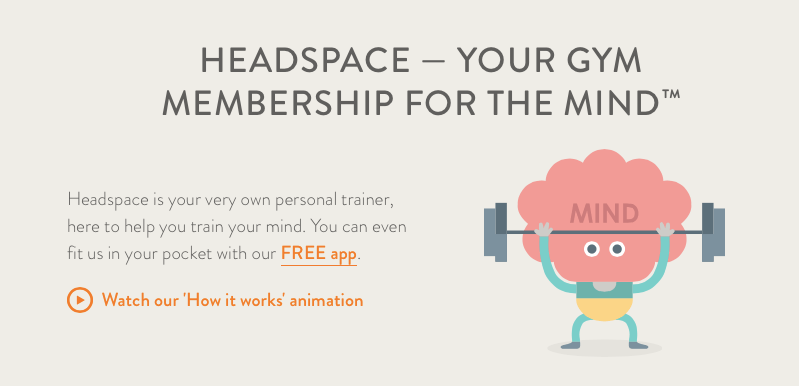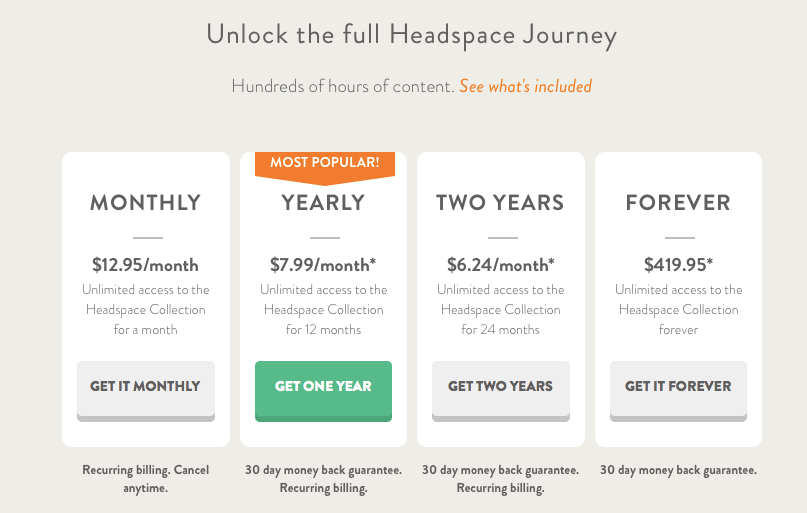A Monk in Your Pocket: The Digitization of Mindfulness

As I emerge from the basement of Aldrich, my cell phone finds service and chirps to life. Three new text messages (hi mom!), eight emails, multiple calendar reminders, a software update, two Slack notifications, my weight tracker telling me to weigh in, Mint tells me I’m spending too much, and a new podcast starts to download. I’m so distracted I almost run into someone as I walk.
Today, 92% of US adults own a mobile phone and 68% have a smartphone.[1] More than two-thirds of us live lives punctuated by notifications; a recent Nielsen analysis found that on average, U.S. smartphone users accessed 26.7 apps per month[2].
We have a hard time putting our phones down. According to the FCC, at any given moment across America, 660,000 drivers are using cell phones while driving[3]. And according to a recent Reuters survey, two thirds of the people said they sleep with their cell phones.
We’re always connected. And this has led to a strange, but perhaps inevitable oxymoron: apps promoting mindfulness.
Headspace, a guided meditation and mindfulness app, bills itself as a “gym membership for the mind.” Launched in 2010 by a Buddhist monk and his business partner, today Headspace has more than 5 million users in 190 countries[4].
Although mindfulness meditation has been around for millennia, it traditionally was a monastic practice[5]. Monks would spend hours in meditation every day. In the 1960s, meditation centers began opening in the United States. In the late 1970s, Jon Cabot-Zin began experimenting with mindfulness in a clinical setting and developed Mindfulness-Based Stress Reduction. Today, Headspace delivers guided meditations in just 10-minute increments for entry-level meditators. Despite the app’s soothing voice and pastel colors, Headspace is marketed as more science than spiritual[6]. The company has a Chief Medical Officer, takes on research partners and has completed clinical trials showing the effectiveness of Headspace as an intervention.
The secularization of meditation and decoupling from Buddhism is not without criticism – some have said this is commodifying Eastern traditions for Western consumption. Despite this, meditation continues to rise in popularity: Ray Dalio, of Bridgewater Associates, said, “Meditation more than anything in my life was the biggest ingredient for whatever success I’ve had.” Goldman Sachs bought bulk subscriptions to Headspace for their employees.
Although Headspace doesn’t release engagement data, after its unlimited free trial, the model is subscription based, suggesting users find value in continued use. This stands out in the app world: 26% of apps downloaded by consumers are never used a second time [7]. Headspace seems to have unusually strong loyalty among users with users attributing improved quality of life to the app, which has a 5-star rating. One recent user wrote, “I never write reviews but I’m compelled to write this one. I battle with anxiety and PTSD. I’ve been introduced to meditation in the past and found it slow and boring. I was never able to sit still long enough to keep up the practice. Recently my doctor suggested this app and from the first day I was hooked.[8]”
Looking ahead, the biggest risk to Headspace is whether mindfulness meditation is a trend that will go the way of Atkins and aromatherapy. The good news for Headspace is that unlike many health fads, the medical community is backing them[9].
There are opportunities to make the app stickier. The app already has the option of sending users mindfulness alerts throughout the day, but if integrated with wearable technology, this could be targeted and the app could ping users when heart rates rises above a certain threshold. And just as more insurance companies offer discounts to users who share health data from wearable devices, Headspace could partner with corporations and/or insurers who could provide coverage discounts to users who use Headspace on a regular basis.
In an ever-more distracted world, Headspace isn’t demanding clicks and eyeballs, instead they ask us to close our eyes and take a breath.
(789 words)
Sources:
[1] Anderson, M. (2015, October 29). Technology device ownership: 2015. Retrieved November 18, 2016, from http://www.pewinternet.org/2015/10/29/technology-device-ownership-2015/
[2] So many Apps, so much more time for entertainment. (2015, June 11). Retrieved November 18, 2016, from http://www.nielsen.com/us/en/insights/news/2015/so-many-apps-so-much-more-time-for-entertainment.html
[3] The dangers of distracted driving. (2016, October 25). Retrieved November 18, 2016, from https://www.fcc.gov/consumers/guides/dangers-texting-while-driving
[4] A simple idea can change the world. (2016). Retrieved November 18, 2016, from https://www.headspace.com/about-us
[5] Gilsinan, K. (2015, July 6). The brains of the Buddhists. The Atlantic. Retrieved from http://www.theatlantic.com/health/archive/2015/07/dalai-lama-neuroscience-compassion/397706/
[6] Widdicombe, L. (2015, July 27). The Higher Life: A Mindfulness Guru for the Tech Set. The New Yorker. Retrieved from http://www.newyorker.com/magazine/2015/07/06/the-higher-life
[7] Suthoff B. (2015, July 10). First impressions matter! 26% of apps downloaded in 2010 were used just once Localytics; 2011 http://info.localytics.com/blog/first-impressions-26-percent-of-apps-downloaded-used-just-once.
[8] Headspace: Guided meditation and Mindfulness on the App store. (2016, November 2). Retrieved November 18, 2016, https://itunes.apple.com/app/headspace-on-the-go/id493145008?utm_source=headspace&utm_medium=weblink&utm_campaign=app_page
[9] Tang, Y.-Y. (2015). The neuroscience of mindfulness meditation. Nature Reviews Neuroscience, 16(4), 213–225. doi:10.1038/nrn3916





Meditation apps are great… I’ve never used Headspace but am not curious and will check it out.
A few questions:
In what ways do you think that apps like Headspace have affected the meditation “business”? Do you think it has “disrupted” the business in any way? I am curious to hear your thoughts because the way I see it, I think that apps like these have probably helped the “industry” by promoting meditation/ increasing awareness (and thus getting more people to go to meditation centers) rather than “stealing” customers.
Fantastic post Sarah! Before HBS, I was a practicing yogi attending class at least 3 times a week. Since arriving at school, this form of meditation has completely dropped from my schedule and I’m constantly searching for opportunities to fit in meditation time. I was one of your cited user who used the free version of Headspace and never upgraded to a paid account…this article was a perfect reminder that maybe it’s time to upgrade.
Personally, I feel the break from spiritual to scientific was a fantastic strategy for Headspace. I believe this helps the everyday user accept the benefits of meditation without having to commit to or connect to the spiritual aspects. As meditation has been around for millenia, how do you see this app transforming in the future? For instance, we’ve all seen the incremental steps apps like Uber, Snapchat and Instragram have taken to stay relevant. Is there room for Headspace to improve and grow?
Thanks for the post Sarah! It is pretty amazing that you can now meditate while being guided by an app in what was traditionally an in-person experience. My question is around efficacy–beyond just subscription statistics, how does Headspace do versus in-person or other traditional meditation guides? There have been numerous apps that promise to teach you a new language or help you work out better, but generally it seems like language teachers and personal trainers continue to offer better value. More generally as apps become more effective at teaching us things, I can see a long-term threat to schools like ours (HBX!) and both the price and perceived value of our educations.
Awesome post! I am a HUGE fan of Headspace. I do not think meditation and mindfulness is a trend – it seems here to stay. I’d like to know more stats about the business – number of paying subscribers, etc. I am concerned that we’re living in the YouTube world as a result, asking someone to pay for this kind of guided meditation is challenging. For example, I do all of my yoga just based on YouTube videos. I think they need to continue to evolve the service to provide value added offerings that simply can’t be found on YouTube in order to make it a viable business.
Hi Sarah–great post! The bulk purchases by companies like GS are certainly pointed endorsements of app-based meditation. I was curious about two things: How defensible do you think Headspace is from competitors? And, is there any data on the choices customers are making about plan price/duration? I was really interested in the “forever” option. I can’t think of a similar option offered elsewhere–clearly a sign that the company expects to be around for a while. Do you think people are actually signing up for this (or any of the longer term options)? Or is this a company better marketed towards company bulk purchases?
Hey Sarah! Great post. I’ve used Headspace before and really loved it, but ultimately did not stick around as a customer. I think there’s some opportunity to make the app “stickier” as you mentioned. I think it is critical they go beyond sending push notifications and really find creative ways to engage the customer (Youtube, Social Media, using web-enabled devices since its currently only available via phone app). I dropped off because I didn’t incorporate the app into my daily routine so I just forgot about it. Even more than just linking it to a wearable device, I think Headspace should link to the user’s calendar and block off time so that the user knows that time is off-bounds.
Great post, Sarah, thanks! Barbara, I would be weary of having Headspace customers on youtube and social media because those are hubs of noise and distraction. However, I agree that they should use the calendar to block off times in order to build habit and make this stick. Perhaps Headspace could find synergies with an app like Freedom, which allows users to block websites and social media (or just everything) at predetermined hours.
Sarah,
To me, this is one of the murkiest questions. Thank you very much for addressing this topic. Can we truly practice presence while still connected to the device that perpetually threatens our ability to be present? I still work part time for a non-profit organization focused on advocating the need to practice silence and silent meditation as a part of a healthy life, both spiritually and naturally. We were all fascinated and perhaps a bit skeptical when we were introduced to Headspace. The IPhone is what is coming between people and silence, and now we are using it to achieve silence? It seemed like too much conflict but after trying it a number of times, the appeal became obvious and the benefits were observable. I finally came to the conclusion that whether it is a lecture, or church, or a yoga mat or even an IPhone app built to help you include silence and meditative practice into your day, than it is worth the price of admission. In my opinion, the destination of meditation and silence is so crucial to a well balance life that whatever road gets you there is fine by me!